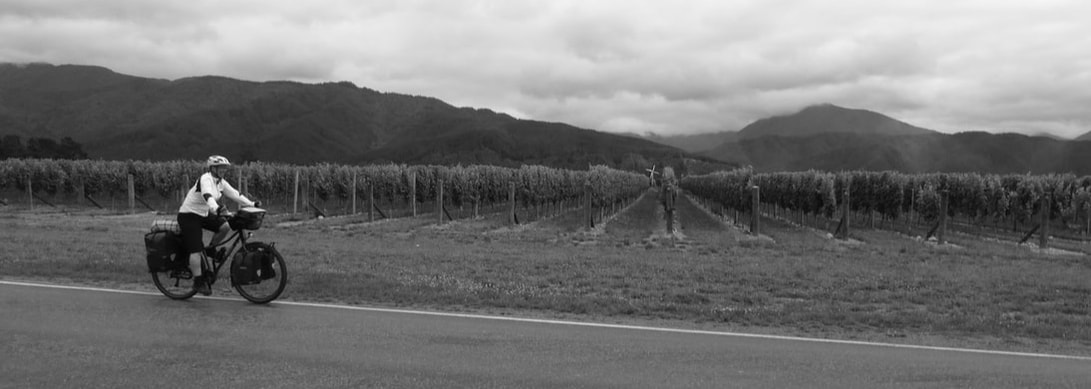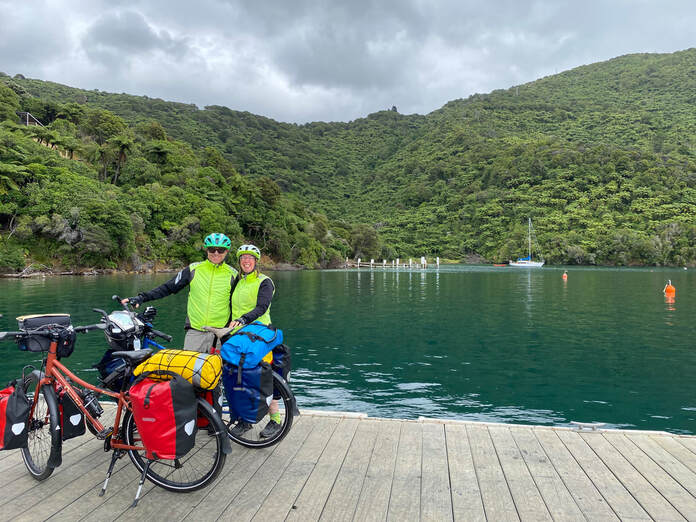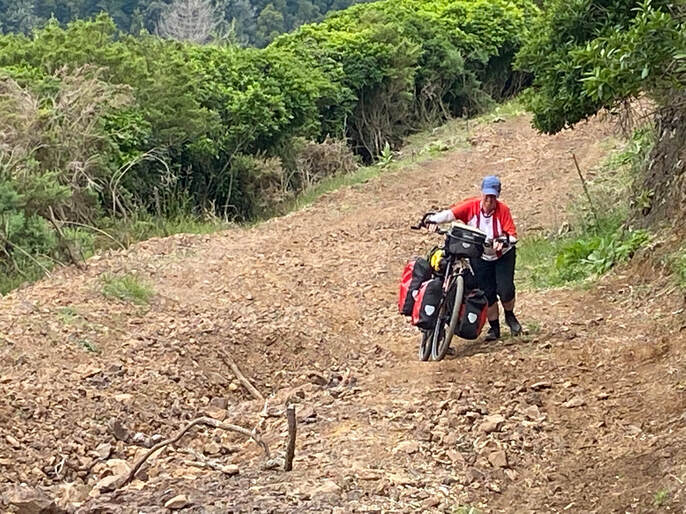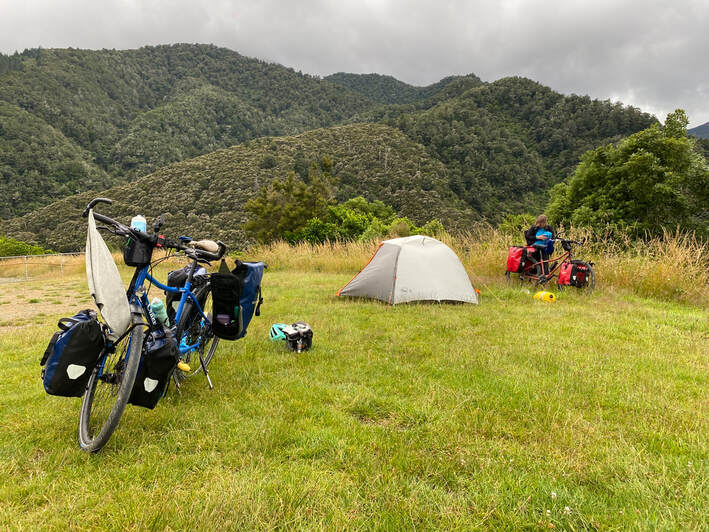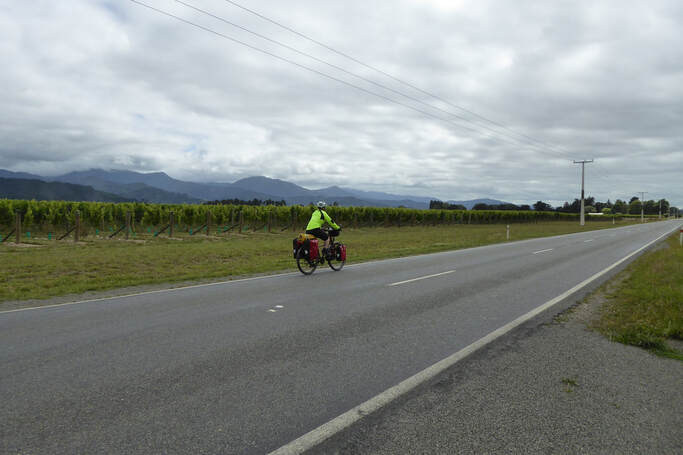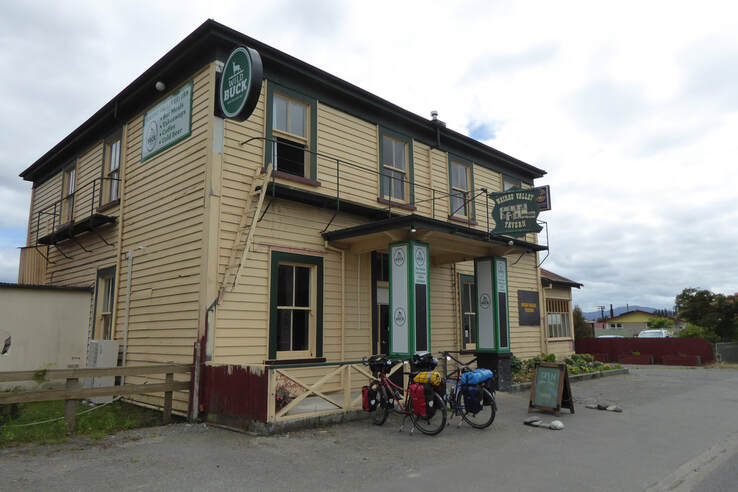Top of the South
2023.01.09
New Zealand - Marlborough, Nelson & Tasman
Rescued by kindness
You know it has been a mammoth bike ride when you’ve been rescued three times.
My husband Kel and I have ridden our bikes up steep Polish mountains, along windblown Estonian island gravel, and over the Cascade, Bitterroot and Rocky mountain ranges in the United States.
We’ve cycled through New Zealand gales, Lithuanian ice and a scorching heatwave in Montana, USA.
Yet, never before have we required rescuing.
This January, we cycled what was supposed to be a 512.8 km round trip from Picton at the top of the South Island.
However, even with our wonderful new, hard-core touring bikes built to handle New Zealand trails and gravel roads, this was reduced to 400 km because of one impossibly difficult track.
It all started off beautifully. We left Picton on a cloudy morning aboard Beachcomber Cruises’ Mail Boat amid the fresh air and blue waters of Queen Charlotte Sound.
Our friendly captain Jason dropped us off at Punga Cove and we spent the day cycling a quiet road along Kenepuru Sound, repetitively up and down around native bush-rimmed bays.
For ages, the only sound was birdsong, especially kererū. Teal water eventually turned turquoise when clouds cleared and the sun appeared.
The boat cruise meant we’d started later than usual, so after a stint on the main road to Havelock, we pedalled in the dark to the Department of Conservation Pelorus Bridge campground.
The next morning remained blissful as we sat by our camp stove, enjoying porridge and coffee and listening to the river clashing and clinking against rocks.
All this was to change when we ascended the Maungatapu Track, which climbs to about 800 m. As we entered the track, a sign said the Maungatapu Saddle was 12.5 km away.
We’ve cycled through New Zealand gales, Lithuanian ice and a scorching heatwave in Montana, USA.
Yet, never before have we required rescuing.
This January, we cycled what was supposed to be a 512.8 km round trip from Picton at the top of the South Island.
However, even with our wonderful new, hard-core touring bikes built to handle New Zealand trails and gravel roads, this was reduced to 400 km because of one impossibly difficult track.
It all started off beautifully. We left Picton on a cloudy morning aboard Beachcomber Cruises’ Mail Boat amid the fresh air and blue waters of Queen Charlotte Sound.
Our friendly captain Jason dropped us off at Punga Cove and we spent the day cycling a quiet road along Kenepuru Sound, repetitively up and down around native bush-rimmed bays.
For ages, the only sound was birdsong, especially kererū. Teal water eventually turned turquoise when clouds cleared and the sun appeared.
The boat cruise meant we’d started later than usual, so after a stint on the main road to Havelock, we pedalled in the dark to the Department of Conservation Pelorus Bridge campground.
The next morning remained blissful as we sat by our camp stove, enjoying porridge and coffee and listening to the river clashing and clinking against rocks.
All this was to change when we ascended the Maungatapu Track, which climbs to about 800 m. As we entered the track, a sign said the Maungatapu Saddle was 12.5 km away.
Flood damage nightmare
What our internet research hadn’t shown, and two enthusiastic locals hadn’t known, was that floods last August had rendered the remote pylon maintenance road unable to be ridden.
In normal times, the track would have been challenging for pannier-laden touring bikes because of several steep ascents and gradients of up to 19.6 per cent.
But the floods had turned the road into a nightmare of trenches and rocks, closing it to four-wheel drives. By the time we realised the extent of the damage, we’d gone too far to turn back.
The term “push bikes” took on horrific meaning as we walked them uphill for hours, stopping to recover strength in the few safe, flat spaces around.
Narrow, slippery slopes, often on the edge of steep downward banks, were the only way around many trenches.
In normal times, the track would have been challenging for pannier-laden touring bikes because of several steep ascents and gradients of up to 19.6 per cent.
But the floods had turned the road into a nightmare of trenches and rocks, closing it to four-wheel drives. By the time we realised the extent of the damage, we’d gone too far to turn back.
The term “push bikes” took on horrific meaning as we walked them uphill for hours, stopping to recover strength in the few safe, flat spaces around.
Narrow, slippery slopes, often on the edge of steep downward banks, were the only way around many trenches.
Our reputable 47 mm-wide tyres supporting 40 kg bicycles together with loaded panniers kept getting stuck on the larger rocks and the bikes just wouldn’t move.
Kel parked his bike in precarious spots and walked back to push my bike from behind, as I walked, pushed, manoeuvred and propelled it.
For the last third of the ascent, we alternated, together pushing each bicycle about 20 metres. Both physically and mentally it was tough.
Our bikes transport our tent, camp stove, wet weather clothing, tools, first aid kit and enough water and food for daily and emergency needs.
Although the loads proved burdensome, it was a relief to know that if we couldn’t get through the track by nightfall, we were equipped to sleep overnight.
However, once we’d almost reached the cloud line and pylons, we were rescued by an experienced German mountain biker who’d also walked his bicycle uphill.
Bernt from Munich kindly pushed my bike to the top of the Maungatapu Saddle, leaving Kel and I to push his.
Once there, we all briefly celebrated, thinking we could ride the long descent. However, the damaged road’s trenches, gradient and sharp rocks meant this was impossible and dangerous.
We later met a Japanese visitor who cracked some ribs that same day, trying to cycle Maungatapu.
About 9 p.m., we finally made it out of the track to flat ground, pitched our tent and flopped into our sleeping bags. Raindrops began to pitter-patter on the fly.
Kel parked his bike in precarious spots and walked back to push my bike from behind, as I walked, pushed, manoeuvred and propelled it.
For the last third of the ascent, we alternated, together pushing each bicycle about 20 metres. Both physically and mentally it was tough.
Our bikes transport our tent, camp stove, wet weather clothing, tools, first aid kit and enough water and food for daily and emergency needs.
Although the loads proved burdensome, it was a relief to know that if we couldn’t get through the track by nightfall, we were equipped to sleep overnight.
However, once we’d almost reached the cloud line and pylons, we were rescued by an experienced German mountain biker who’d also walked his bicycle uphill.
Bernt from Munich kindly pushed my bike to the top of the Maungatapu Saddle, leaving Kel and I to push his.
Once there, we all briefly celebrated, thinking we could ride the long descent. However, the damaged road’s trenches, gradient and sharp rocks meant this was impossible and dangerous.
We later met a Japanese visitor who cracked some ribs that same day, trying to cycle Maungatapu.
About 9 p.m., we finally made it out of the track to flat ground, pitched our tent and flopped into our sleeping bags. Raindrops began to pitter-patter on the fly.
Beautiful riding
For the next few days, in cloudy yet fine weather, we enjoyed beautiful riding on the remainder of the Marlborough-Tasman route Kel had devised.
This included Tasman’s Great Taste Trail, which we took from Nelson to Wakefield via Rabbit Island and Tapawera. This superb trail wound past an estuary, forest-fringed beaches and dairy, beef, sheep, poultry and hop farms.
Our Maungatapu adventure had put us about 75 km behind schedule but the host from our accommodation at Pedallers’ Nest generously picked us up from Māpua, saving us another 9 p.m. arrival.
On our only non-camping night, we relished a hot outdoor shower, fresh farm food and a comfy bed in an old stable.
The next day, our bikes’ dynamo-powered headlights helped but sunglasses didn’t when we rode through the dark, damp, 1.4 km long Spooners Tunnel.
From Wakefield, we delighted in the solitude of fields, forestry and conservation land as we pedalled through Golden Downs, over two grade-3 climbs to Tophouse Junction and alongside Wairau Valley vineyards.
This included Tasman’s Great Taste Trail, which we took from Nelson to Wakefield via Rabbit Island and Tapawera. This superb trail wound past an estuary, forest-fringed beaches and dairy, beef, sheep, poultry and hop farms.
Our Maungatapu adventure had put us about 75 km behind schedule but the host from our accommodation at Pedallers’ Nest generously picked us up from Māpua, saving us another 9 p.m. arrival.
On our only non-camping night, we relished a hot outdoor shower, fresh farm food and a comfy bed in an old stable.
The next day, our bikes’ dynamo-powered headlights helped but sunglasses didn’t when we rode through the dark, damp, 1.4 km long Spooners Tunnel.
From Wakefield, we delighted in the solitude of fields, forestry and conservation land as we pedalled through Golden Downs, over two grade-3 climbs to Tophouse Junction and alongside Wairau Valley vineyards.
After two nights camping with no running water or shops, the Wairau Valley Tavern felt like paradise.
We enjoyed excellent coffee, home-baked cheese scones and hospitality, as well as the feeling of tap water and soap washing sun-screen and insect repellent off our hands and faces.
Tar-seal roads continued through Renwick, Spring Creek and Rarangi, where we confirmed our decision to cycle 40 km to Picton via the coast instead of busy State Highway 1.
We enjoyed excellent coffee, home-baked cheese scones and hospitality, as well as the feeling of tap water and soap washing sun-screen and insect repellent off our hands and faces.
Tar-seal roads continued through Renwick, Spring Creek and Rarangi, where we confirmed our decision to cycle 40 km to Picton via the coast instead of busy State Highway 1.
Two more rescues
The next two rescues weren’t in as dramatic circumstances as the appearance of Bernt from Munich.
They occurred during this last stretch from Rarangi to Picton. We knew 25 km would be gravel, however after starting off, one segment was too loose to cycle, so we returned to “push bikes” mode.
A considerate carpenter and his daughter Elsie took me, my bike and all our panniers in their ute 4.5 km to Robin Hood Bay, where they were going surfing.
Kel cycled more quickly without his panniers and wife!
The gravel improved and we both rode on. Regrettably, we’d given ourselves a deadline for reaching Picton. The frequent winding hills, dipping down into bays then up again, took more time than we’d estimated. We decided to “hitch-bike”.
So, roll up Michelle from Christchurch in her seven-seater packed with three children and holiday camping gear. She had a rear rack and managed to stuff in our bikes, luggage and bodies.
We shared a pleasant 19 km drive along stunning coastline until she left us at Karaka Point, from where we cycled 9 km to Picton and the end of an unforgettable trip.
Footnote: Two days after we tried to ride the Maungatapu Track, the Nelson City Council closed it to all users because of the damage.
They occurred during this last stretch from Rarangi to Picton. We knew 25 km would be gravel, however after starting off, one segment was too loose to cycle, so we returned to “push bikes” mode.
A considerate carpenter and his daughter Elsie took me, my bike and all our panniers in their ute 4.5 km to Robin Hood Bay, where they were going surfing.
Kel cycled more quickly without his panniers and wife!
The gravel improved and we both rode on. Regrettably, we’d given ourselves a deadline for reaching Picton. The frequent winding hills, dipping down into bays then up again, took more time than we’d estimated. We decided to “hitch-bike”.
So, roll up Michelle from Christchurch in her seven-seater packed with three children and holiday camping gear. She had a rear rack and managed to stuff in our bikes, luggage and bodies.
We shared a pleasant 19 km drive along stunning coastline until she left us at Karaka Point, from where we cycled 9 km to Picton and the end of an unforgettable trip.
Footnote: Two days after we tried to ride the Maungatapu Track, the Nelson City Council closed it to all users because of the damage.
If you liked this article, join up to our Daily Encourager Media Facebook page by clicking here
For further information:
Tasman’s Great Taste Trail
Golden Downs Trail
Pedaller’s Nest
For further information:
Tasman’s Great Taste Trail
Golden Downs Trail
Pedaller’s Nest
